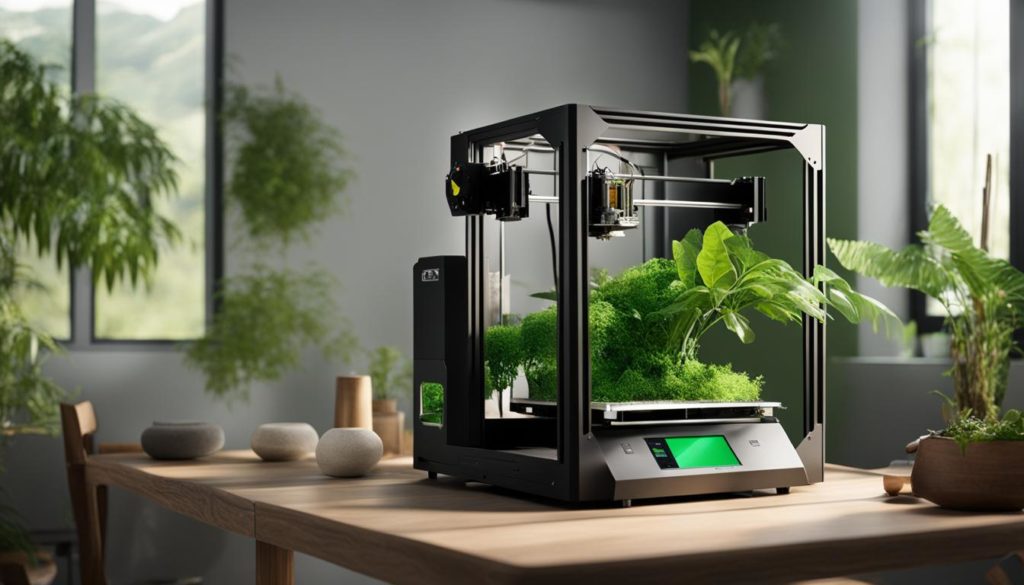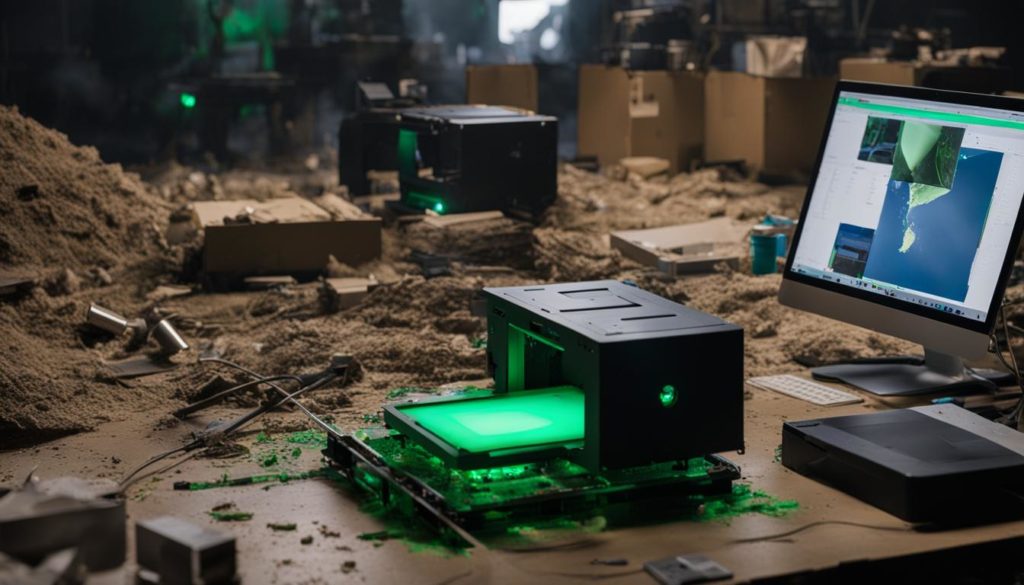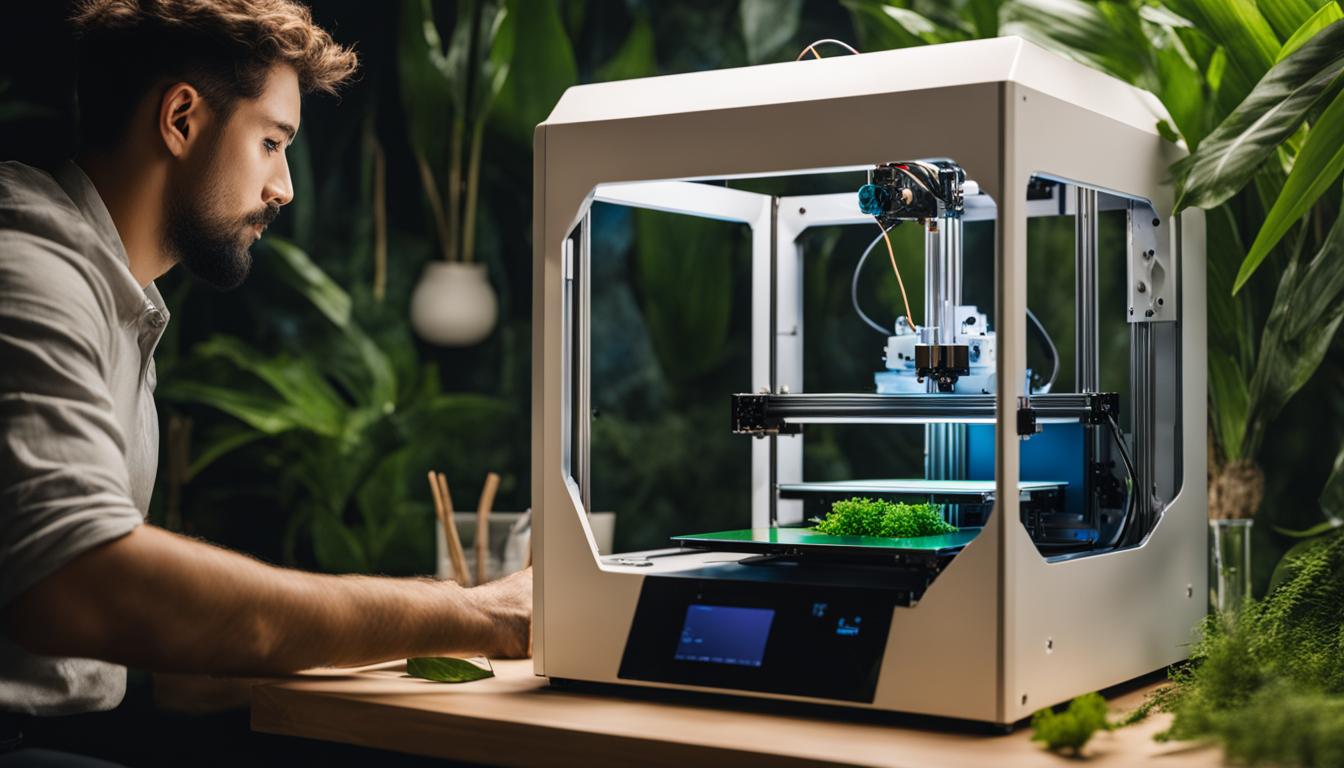Eco-friendly 3D printing technology is revolutionizing the manufacturing industry with its sustainable additive manufacturing methods and green innovations. As concerns about the environment continue to grow, this technology offers a way to reduce waste, lower energy consumption, and make a positive impact on both the planet and the industry.
Key Takeaways:
- Eco-friendly 3D printing technology offers sustainable additive manufacturing methods.
- It reduces waste and lowers energy consumption.
- 3D printing has a positive impact on both the environment and the industry.
- Green 3D printing innovations are gaining popularity.
- This technology is revolutionizing production processes and promoting sustainability.
Overview of Climate Change and its Consequences
Climate change is a pressing global issue that has far-reaching consequences for our planet. The burning of fossil fuels and deforestation have led to an increase in carbon emissions, resulting in global warming. The rise in average temperatures has caused significant changes in weather patterns, leading to more frequent and severe droughts, floods, and storms.
One of the most concerning effects of climate change is the melting of ice caps and rising sea levels. As polar ice melts, it adds more water to the world’s oceans, causing sea levels to rise. This poses a threat to coastal communities and low-lying areas, increasing the risk of flooding and erosion.
These changes in climate have a profound impact on ecosystems and biodiversity. Many species are struggling to adapt to the rapidly changing conditions, leading to habitat loss and the potential extinction of certain plants and animals. The consequences of climate change also extend to human populations, affecting food supplies, water resources, and public health.
| Climate Change Impacts | Consequences |
|---|---|
| Rising global temperatures | Heatwaves, droughts, and wildfires |
| Rising sea levels | Coastal flooding, erosion, and displacement of communities |
| Extreme weather events | More frequent and severe storms, hurricanes, and floods |
| Disruption of ecosystems | Habitat loss, species extinction, and decline in biodiversity |
| Impact on human populations | Food and water scarcity, public health risks, and migration |
It is crucial that we take immediate action to mitigate climate change and reduce carbon emissions. Transitioning to renewable energy sources, implementing sustainable practices in agriculture and industry, and adopting climate-friendly policies are key strategies in addressing this global crisis. By working together, we can strive towards a more sustainable and resilient future.
Why Environmental Impact Matters for Manufacturers
Manufacturing processes can have a significant environmental impact, contributing to carbon emissions and resource depletion. As the world becomes more aware of the need for sustainability, businesses are recognizing the importance of mitigating their environmental footprint. Adopting sustainable business practices not only helps protect the planet but also brings numerous benefits to manufacturers.
Improved Operational Efficiency
By implementing sustainable practices, manufacturers can improve their operational efficiency. Energy-efficient equipment, optimized production processes, and waste reduction measures can result in cost savings and increased productivity. For example, using energy-saving technologies and optimizing supply chains can significantly reduce energy consumption and lower carbon emissions.
A study conducted by the United Nations Industrial Development Organization found that sustainable manufacturing practices can lead to energy savings of up to 30%. These savings translate into reduced operating costs and increased profitability for manufacturers.
Consumer Loyalty and Brand Reputation
Consumers are increasingly conscious of the environmental impact of the products they buy. They are more likely to support companies that demonstrate a commitment to sustainability. By implementing eco-friendly manufacturing processes, businesses can enhance their brand reputation and attract environmentally conscious consumers.
A survey conducted by Nielsen found that 66% of consumers are willing to pay more for products and services from companies committed to positive environmental and social impact. By adopting sustainable business practices, manufacturers can tap into this growing consumer demand and gain a competitive edge in the market.
| Benefits of Sustainable Business Practices for Manufacturers | Key Findings |
|---|---|
| Improved Operational Efficiency | Sustainable practices can lead to energy savings of up to 30% and increased profitability. |
| Consumer Loyalty and Brand Reputation | 66% of consumers are willing to pay more for products from socially and environmentally responsible companies. |
| Regulatory Compliance and Risk Mitigation | Adopting sustainable practices helps manufacturers stay compliant with environmental regulations and reduces the risk of legal penalties and reputational damage. |
Regulatory Compliance and Risk Mitigation
Complying with environmental regulations is crucial for manufacturers to avoid legal penalties and reputational damage. By adopting sustainable practices, businesses can ensure compliance with environmental standards and reduce their carbon footprint.
Moreover, sustainable manufacturing practices can help companies mitigate risks associated with resource scarcity and rising energy costs. By diversifying energy sources, optimizing material usage, and reducing waste, manufacturers can minimize their dependency on finite resources and volatile markets.
In conclusion, the environmental impact of manufacturing is a pressing issue that requires urgent attention. Manufacturers need to embrace sustainable business practices to reduce their carbon footprint, improve operational efficiency, and enhance their brand reputation. The benefits of adopting eco-friendly manufacturing processes extend beyond environmental protection and contribute to long-term business success.
How 3D Printing Reduces Environmental Impact
3D printing, also known as additive manufacturing, offers a more sustainable approach to manufacturing compared to traditional methods. It has the potential to significantly reduce environmental impact by minimizing waste and improving energy efficiency.
One of the key advantages of 3D printing is its ability to produce only what is needed, leading to less material waste. Traditional manufacturing often involves the creation of excess inventory, which can result in surplus products that go unsold and eventually contribute to landfill waste. With 3D printing, manufacturers can optimize production by printing objects on-demand, reducing the need for excessive stockpiling.
Additionally, 3D printing eliminates the need for carbon-heavy supply chains. In traditional manufacturing, materials are sourced from various locations and transported to production sites, resulting in significant carbon emissions. In contrast, 3D printing allows for localized production, minimizing the transportation of materials and reducing the overall carbon footprint.
Advantages of 3D Printing in Waste Reduction and Energy Efficiency
Table: Comparison of Waste Reduction and Energy Efficiency in 3D Printing and Traditional Manufacturing
| 3D Printing | Traditional Manufacturing | |
|---|---|---|
| Waste Reduction | Less material waste due to on-demand production | Excess inventory can lead to waste |
| Energy Efficiency | Localized production minimizes transportation and energy consumption | Transportation of materials and products increases energy usage |
Table: Comparison of Waste Reduction and Energy Efficiency in 3D Printing and Traditional Manufacturing.
By adopting 3D printing technologies, companies can reduce their environmental impact while still meeting production needs. However, it is important to address the energy consumption associated with the printing process itself. Efforts are being made to develop more energy-efficient 3D printers and improve the sustainability of the materials used in printing, such as exploring bioplastics made from renewable sources.
3D printing has the potential to revolutionize manufacturing processes and promote sustainability in various industries.
With ongoing advancements in technology and a growing focus on sustainability, 3D printing is poised to play a major role in reducing environmental impact across industries. By embracing this innovative approach, manufacturers can contribute to a more sustainable future and help address the global challenges of waste reduction and energy efficiency.
Examples of Sustainable Manufacturing in Practice
In the quest for sustainable manufacturing, several companies have embraced 3D printing as a means to reduce environmental impact. Greentown Labs and Transaera are two notable examples of companies utilizing 3D printing technology to create sustainable air conditioning systems. By leveraging 3D printing, these companies are able to design and manufacture energy-efficient and affordable air conditioning units, reducing the carbon footprint associated with traditional cooling methods.
Vestas, a global leader in wind energy, has also joined the sustainable manufacturing revolution by incorporating 3D printing into the production of wind turbines. This innovative approach allows Vestas to manufacture zero-waste turbines, reducing the environmental impact of traditional manufacturing processes. By embracing 3D printing, Vestas demonstrates its commitment to sustainability and contributes to the global transition towards renewable energy sources.
To summarize, these examples illustrate the practical application of 3D printing in sustainable manufacturing. By leveraging this technology, companies like Greentown Labs, Transaera, and Vestas are not only reducing their carbon footprint but also driving innovation in their respective industries. With further advancements in 3D printing, we can expect to see a broader adoption of sustainable manufacturing practices that contribute to a greener and more environmentally friendly future.
The Environmental Implications of 3D Printing
While 3D printing offers many sustainability benefits, it is important to consider its environmental implications. One of the main concerns is the high energy consumption associated with the printing process. As 3D printers require power to melt and fuse materials, they can consume significant amounts of electricity. This energy consumption contributes to greenhouse gas emissions and raises questions about the overall sustainability of 3D printing technology.
Another environmental concern is the emissions generated during the 3D printing process. Volatile organic compounds (VOCs) are released when certain materials, such as plastics, are melted and printed. These emissions can contribute to air pollution and have potential health impacts on both human and environmental ecosystems. It is crucial to develop and implement strategies to minimize these emissions and ensure the safe and responsible use of 3D printing.
Additionally, the materials used in 3D printing can have sustainability concerns. While there are eco-friendly options available, such as bioplastics made from plant-based sources, many traditional materials used in 3D printing, such as petroleum-based thermoplastics, are not biodegradable and have a negative environmental impact. However, efforts are underway to develop more sustainable materials for 3D printing, including recycled plastics and biodegradable alternatives, which can help mitigate these concerns and promote a greener approach to additive manufacturing.
It is essential for the 3D printing industry to address these sustainability concerns and work towards reducing energy consumption, emissions, and the use of unsustainable materials. By focusing on eco-friendly innovations, such as improving energy efficiency, using biodegradable and recycled materials, and implementing responsible manufacturing practices, the environmental impact of 3D printing can be minimized. This will not only contribute to a more sustainable future but also ensure the long-term viability of this technology in various industries.
| Environmental Implications | Sustainability Solutions | |
|---|---|---|
| Energy Consumption | High levels of electricity consumption during the printing process | Invest in energy-efficient 3D printers, optimize printing parameters for energy savings, explore alternative energy sources |
| Emissions | Release of volatile organic compounds (VOCs) during printing | Develop VOC capture and filtration systems, use low-emission materials, promote responsible ventilation |
| Material Sustainability | Use of non-biodegradable and unsustainable materials | Expand the use of bioplastics and recycled materials, encourage material recycling programs, explore biofabrication techniques |
The Potential of 3D Printing for Environmental Progress
As the world continues to prioritize sustainability, 3D printing emerges as a promising technology with the potential to contribute significantly to environmental progress. With its ability to save raw materials, reduce waste, and improve efficiency, 3D printing offers a pathway towards a more sustainable future. By 2050, it is estimated that 3D printing could save up to 90% of the raw materials required for traditional manufacturing processes.
One of the key advantages of 3D printing is its waste reduction capabilities. Unlike traditional manufacturing methods that often produce excess materials, 3D printing allows for the production of only what is needed, minimizing waste generation. This not only reduces the environmental impact but also has financial benefits for businesses by cutting down on material costs.
In addition to waste reduction, 3D printing also offers efficiency gains. With the ability to create complex designs and customized products, the technology streamlines production processes and eliminates the need for multiple components. This not only saves time but also reduces energy consumption. By optimizing the manufacturing process, 3D printing can contribute to a more sustainable and resource-efficient industry.
| Benefits of 3D Printing for Environmental Progress |
|---|
| Raw material savings |
| Waste reduction |
| Efficiency gains |
3D printing has the potential to revolutionize various sectors, including manufacturing, construction, and disaster relief. By harnessing the power of this technology, industries can reduce their environmental footprint and contribute to a more sustainable world.
Sustainable Materials for 3D Printing
When it comes to achieving sustainability in 3D printing, the choice of materials plays a crucial role. While traditional thermoplastics are commonly used, they are not biodegradable and require petroleum products for production, which can have a significant environmental impact. However, there is a growing trend towards the use of eco-friendly materials that promote sustainability in this innovative manufacturing process.
One such sustainable material option is bioplastics, which are derived from renewable plant-based sources. Unlike traditional thermoplastics, bioplastics are biodegradable and can significantly reduce the environmental footprint associated with 3D printing. These materials offer the potential to create products that are not only functional and durable but also environmentally friendly.
In addition to bioplastics, recycled materials are also being increasingly used in 3D printing. By repurposing waste materials and converting them into filament for 3D printing, manufacturers can significantly reduce waste and promote a circular economy. This approach not only minimizes the consumption of new resources but also helps to address the issue of plastic waste pollution.

Progressing Sustainability in Business through 3D Printing
Businesses can greatly benefit from incorporating 3D printing technology into their operations. Not only does it offer manufacturing efficiency, but it also promotes circularity and local production, contributing to a more sustainable business model.
One of the key advantages of 3D printing in terms of manufacturing efficiency is its ability to enable on-demand production. This means that businesses can produce goods only when they are needed, eliminating the need for large inventories and reducing waste. By streamlining the production process, businesses can improve operational efficiency and minimize their environmental impact.
Furthermore, 3D printing allows for the creation of spare parts, which promotes circularity within the manufacturing industry. Instead of discarding products when a component fails, businesses can simply print a replacement part, extending the lifespan of the product and reducing waste. This not only saves resources but also reduces costs associated with traditional supply chains.
Another significant advantage of 3D printing is its potential for local production. By bringing production closer to the point of consumption, businesses can reduce the carbon footprint associated with shipping and logistics. Local production also supports the local economy and reduces reliance on global supply chains, making businesses more resilient and flexible in times of disruption. Overall, 3D printing empowers businesses to operate in a more sustainable and environmentally friendly manner.
| Benefits of 3D Printing in Business Sustainability | |
|---|---|
| Manufacturing Efficiency | Streamlines production and reduces waste through on-demand manufacturing. |
| Circularity | Promotes the creation of spare parts, extending product lifespan and reducing waste. |
| Local Production | Reduces carbon footprint, supports the local economy, and increases resilience. |
The Role of 3D Printing in Sustainable Construction
Sustainable construction is a rapidly emerging field that aims to reduce the environmental impact of the building industry. With its ability to optimize material usage and promote local production, 3D printing is playing a crucial role in advancing sustainable practices in construction.
One of the key advantages of 3D printing in sustainable construction is the significant reduction in waste. Traditional construction methods often generate large amounts of construction waste, such as excess concrete and unused materials. In contrast, 3D printing allows for precise material placement, minimizing waste and maximizing resource efficiency. This reduction in waste not only benefits the environment but also helps to lower construction costs.
Moreover, 3D printing enables the production of building components on-site, eliminating the need for lengthy supply chains and transportation. By producing construction elements locally, the carbon footprint associated with traditional construction methods, such as transporting heavy prefabricated components, can be significantly reduced. This localization of production also has the potential to support local economies and reduce dependence on imported materials.
Advantages of 3D Printing in Sustainable Construction:
- Reduced waste through precise material placement
- Lowered carbon footprint by eliminating lengthy supply chains
- Promotion of local production and support for local economies
| Traditional Construction Methods | 3D Printing in Sustainable Construction |
|---|---|
| Generates significant construction waste | Minimizes waste through precise material placement |
| Relies on transportation of prefabricated components | Enables on-site production, reducing transportation needs |
| Dependent on imported materials and global supply chains | Promotes local production and supports local economies |
3D printing in sustainable construction offers a promising pathway towards reducing waste, lowering carbon emissions, and supporting local economies. By embracing this technology, the construction industry can move towards a more sustainable and environmentally-friendly future.
The Potential of 3D Printing in Disaster Relief and Microchip Prototyping
In addition to its applications in sustainable manufacturing and construction, 3D printing is revolutionizing disaster relief efforts and addressing microchip shortages through local production. In times of crises, such as natural disasters or humanitarian emergencies, quick access to essential parts and infrastructure components is crucial. 3D printing offers a solution by enabling on-site production, reducing reliance on global supply chains, and expediting the delivery of critical resources.
Disaster relief organizations can leverage 3D printing technology to create spare parts, tools, and even temporary shelters in affected areas. This localized production capability greatly improves response times and ensures that aid reaches those in need faster. Furthermore, the ability to manufacture these items on-demand reduces costs and waste associated with traditional manufacturing and shipping processes.
Moreover, the microchip shortage has become a significant challenge for many industries, including electronics and automotive. 3D printing presents a viable alternative for prototyping and producing custom microchips locally. By utilizing 3D printing technology, companies can bypass supply chain disruptions and reduce the time required to develop and test new microchip designs. This local production approach not only addresses the immediate challenges posed by the shortage but also contributes to a more resilient and self-sustaining manufacturing ecosystem.
Table: Examples of 3D Printing Applications in Disaster Relief and Microchip Prototyping
| Application | Description |
|---|---|
| On-site Spare Parts Production | 3D printing enables the rapid production of spare parts in disaster-stricken areas, reducing dependence on external supply chains. |
| Infrastructure Repair | 3D printing can be used to fabricate components for infrastructure repair, including bridges, roads, and electrical systems. |
| Customized Prosthetics | With 3D printing, prosthetic limbs can be tailored to individual needs, allowing for faster and more affordable production. |
| Local Microchip Production | 3D printing offers a flexible and cost-effective solution for prototyping and producing microchips locally, reducing reliance on global supply chains. |
By harnessing the potential of 3D printing in disaster relief and microchip prototyping, organizations can respond more effectively to crises and mitigate the impact of supply chain disruptions. This technology not only facilitates faster and more efficient aid delivery but also empowers local communities to take control of their manufacturing needs, fostering self-sufficiency and enhancing resilience.

Conclusion
Eco-friendly 3D printing technology presents a promising future for sustainability in manufacturing and various industries. Despite challenges such as energy consumption and material choice, ongoing efforts are dedicated to enhancing the sustainability of 3D printing. As this technology continues to evolve, it has the potential to revolutionize production processes, minimize waste, and contribute to a more sustainable future.
The rise of eco-friendly 3D printing offers substantial benefits in terms of reduced waste and energy consumption compared to traditional methods. By enabling the production of only what is needed, 3D printing significantly reduces material waste. Additionally, it eliminates the need for carbon-intensive supply chains, resulting in lower carbon emissions.
Although it is essential to consider the environmental implications of 3D printing, such as energy consumption and emissions, progress is being made to develop eco-friendly materials and decrease energy usage during the printing process. Furthermore, ongoing research and development are focused on exploring sustainable materials for 3D printing, including bioplastics made from plant-based sources and the utilization of recycled materials to promote waste reduction.
Looking ahead, the future of 3D printing holds great potential for sustainability. With its ability to save raw materials, reduce waste, and improve efficiency, 3D printing can play a pivotal role in accelerating sustainability initiatives. By 2050, it is projected that 3D printing could save up to 90% of the raw materials required for manufacturing. This technology has the capacity to transform various sectors, contributing to a more environmentally conscious and sustainable future.
FAQ
What is eco-friendly 3D printing technology?
Eco-friendly 3D printing technology refers to sustainable additive manufacturing methods that reduce waste, lower energy consumption, and have a positive impact on the environment.
What are the consequences of climate change?
Climate change has consequences such as increasing average temperatures, extreme weather patterns, and rising sea levels caused by melting ice caps, which have significant impacts on ecosystems, food supplies, and human populations.
Why does environmental impact matter for manufacturers?
Environmental impact matters for manufacturers because high energy consumption and carbon emissions in the manufacturing process contribute to climate change. Implementing sustainable business practices improves operational efficiency and consumer loyalty.
How does 3D printing reduce environmental impact?
3D printing reduces environmental impact by reducing waste through on-demand production, eliminating the need for carbon-heavy supply chains, and lowering energy consumption compared to traditional manufacturing methods.
Can you provide examples of sustainable manufacturing through 3D printing?
Greentown Labs and Transaera are using 3D printing to create sustainable air conditioning systems, while Vestas is producing zero-waste wind turbines. These examples demonstrate practical applications of sustainable manufacturing through 3D printing.
What are the environmental implications of 3D printing?
While 3D printing offers sustainability benefits, it can consume high energy levels and emit volatile organic compounds (VOCs). The materials used, such as plastics, can also be unsustainable. Efforts are being made to develop eco-friendly materials and reduce energy consumption in the printing process.
How can 3D printing contribute to environmental progress?
3D printing has the potential to save up to 90% of the raw materials required for manufacturing by 2050. It can also reduce waste and improve efficiency, accelerating sustainability initiatives and contributing to a more sustainable future.
What sustainable materials are used in 3D printing?
While traditional thermoplastics are commonly used, there is a rise in the use of eco-friendly materials such as bioplastics made from plant-based sources. Recycled materials are also being utilized to reduce waste and promote sustainability in 3D printing.
How can businesses benefit from implementing 3D printing technology?
Businesses can benefit from improved manufacturing efficiency, circularity through the production of spare parts, and reduced carbon footprint associated with shipping and energy use. 3D printing allows for on-demand production, eliminating the need for large inventories and reducing waste and costs.
How can 3D printing contribute to sustainable construction?
3D printing can reduce waste, shorten supply chains, and produce components locally, leading to a reduction in the carbon footprint of the construction industry and promoting more sustainable building practices.
How can 3D printing support disaster relief efforts and address microchip shortages?
3D printing enables the efficient production of spare parts and infrastructure components on-site, aiding disaster relief efforts. It has also been used to address microchip shortages and promote local production, reducing reliance on global supply chains.
What is the future of eco-friendly 3D printing technology?
As efforts continue to improve the sustainability of 3D printing, the technology has the potential to revolutionize production processes, reduce waste, and contribute to a more sustainable future.
- Visionary Leadership: Why Saudi Arabia Should Launch a Dedicated Cargo Airline - December 11, 2024
- Why Employee Opinion Surveys in the Air Cargo Don’t Work - December 10, 2024
- E-Trucks: The Future of Local Pickup and Drop-offs in the Air Cargo Industry - December 9, 2024






